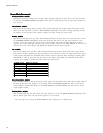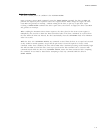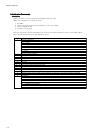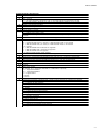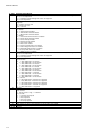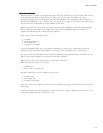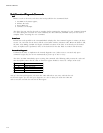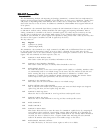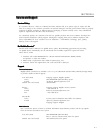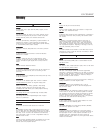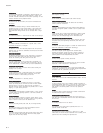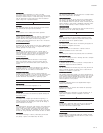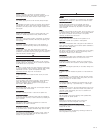
GLOSSARY
GL – 1
GLOSSARY
GlossaryGlossary
GlossaryGlossary
Glossary
AA
AA
A
ACCESSACCESS
ACCESSACCESS
ACCESS
To obtain data from, or place data into, RAM, a register, or data
storage device.
ACCESS TIMEACCESS TIME
ACCESS TIMEACCESS TIME
ACCESS TIME
The interval between the issuing of an access command and the
instant that the target data may be read or written. Access time
includes seek time, latency and controller overhead time.
ADDRESSADDRESS
ADDRESSADDRESS
ADDRESS
A number, generally binary, distinguishing a specific member of an
ordered set of locations. In disk engineering, the address may
consist of drives (unit address), radial positions (cylinder address),
or circumferential position (sector address).
ALLOCATIONALLOCATION
ALLOCATIONALLOCATION
ALLOCATION
A process of assigning designated areas of the disk to particular
files.
ALTERNATE TRACKALTERNATE TRACK
ALTERNATE TRACKALTERNATE TRACK
ALTERNATE TRACK
A spare track used in the event that a normal track becomes
damaged or is unusable.
ANALOGANALOG
ANALOGANALOG
ANALOG
A signal or system that does not use digital states to convey
information. A signal may have any number of significant states
(values), contrasted to digital signals which can only have two
states.
ANSIANSI
ANSIANSI
ANSI
American National Standards Institute.
APPLICATION PROGRAMAPPLICATION PROGRAM
APPLICATION PROGRAMAPPLICATION PROGRAM
APPLICATION PROGRAM
A sequence of programmed instructions that tell the computer how
to perform some end-user task, such as accounting or word
processing.
AREAL DENSITYAREAL DENSITY
AREAL DENSITYAREAL DENSITY
AREAL DENSITY
Bit density (bits per inch) multiplied by track density (tracks per inch)
or bits per square inch.
ASYMMETRYASYMMETRY
ASYMMETRYASYMMETRY
ASYMMETRY
A distortion of the readback signal which is shown in different
intervals between the positive and negative voltage peaks.
AUXILIARY MEMORYAUXILIARY MEMORY
AUXILIARY MEMORYAUXILIARY MEMORY
AUXILIARY MEMORY
Memory other than main memory; generally a mass-storage
subsystem containing disk drives and backup tape drives,
controller(s) and buffer memory (also called peripheral memory).
AVERAGE ACCESS TIMEAVERAGE ACCESS TIME
AVERAGE ACCESS TIMEAVERAGE ACCESS TIME
AVERAGE ACCESS TIME
The average time to make all possible length accesses (seeks).
AVERAGE SEEK TIMEAVERAGE SEEK TIME
AVERAGE SEEK TIMEAVERAGE SEEK TIME
AVERAGE SEEK TIME
The average time to make all possible length seeks. A typical
measure of performance.
BB
BB
B
BAD BLOCKBAD BLOCK
BAD BLOCKBAD BLOCK
BAD BLOCK
A block that cannot store data because of a media flaw.
BITBIT
BITBIT
BIT
An abbreviation for binary digit, of which there are two (0 and 1). A
bit is the basic data unit of most digital computers. A bit is usually
part of a data byte or word, but bits may be used singly to control or
read logic “on-off” functions. The fundamental unit information,
often used loosely to refer to a circuit or magnetization state at a
particular instant in time.
BIOSBIOS
BIOSBIOS
BIOS
Acronym for Basic Input/Output System. The firmware area of a CPU
that controls operations through the system bus and to the
attached cards and peripheral devices.
BPIBPI
BPIBPI
BPI
Acronym for bits per inch. See bit density.
BLOCKBLOCK
BLOCKBLOCK
BLOCK
A group of bytes handled, stored, and accessed as a logical data
unit, such as an individual file record.
BUFFERBUFFER
BUFFERBUFFER
BUFFER
A temporary data storage area that compensates for a difference in
data transfer rates and/or data processing rates between sender
and receiver.
BUSBUS
BUSBUS
BUS
A collection of functionally parallel conductors that forms an
interconnection between functional blocks in a digital device. A
length of parallel conductors that forms a major interconnection
route between the computer system CPU (central processing unit)
and its peripheral subsystems. Depending on its design, a bus may
carry data, addresses, power, and more.
BYTEBYTE
BYTEBYTE
BYTE
An ordered collection of bits treated as a unit. Most often, a byte is
understood to consist of eight bits. One byte is necessary to define
an alphanumeric character.
CC
CC
C
CACHECACHE
CACHECACHE
CACHE
Random access memory (RAM) used as a buffer between the CPU
and the disk drive.
CAPACITYCAPACITY
CAPACITYCAPACITY
CAPACITY
The amount of data, usually expressed in bytes, which can be stored
in a given device or portion of same.
CENTRAL PROCESSING UNIT (CPU)CENTRAL PROCESSING UNIT (CPU)
CENTRAL PROCESSING UNIT (CPU)CENTRAL PROCESSING UNIT (CPU)
CENTRAL PROCESSING UNIT (CPU)
The heart of the computer system that executes programmed
instructions. It includes the arithmetic logic unit (ALU) for performing
all math and logic operations, a control section for interpreting and
executing instructions, internal memory for temporary storage of
program variables and other functions.
CHANNELCHANNEL
CHANNELCHANNEL
CHANNEL
A collection of electronic circuits used in the process of writing and
reading information to and from magnetic media.
CHARACTERCHARACTER
CHARACTERCHARACTER
CHARACTER
An ordered collection of bits representing one of a set of
predefined symbols. Often the term is used interchangeably with
byte, but this is inexact.
CLOSED LOOPCLOSED LOOP
CLOSED LOOPCLOSED LOOP
CLOSED LOOP
A control technique that enables the positioning system to correct
off-track errors in real time. The actual head position is monitored
and compared to the ideal track position to determine any position
error that might be occurring. This information is then used to
produce a correction signal (feedback) that goes to the positioner
to correct the error. (See also track following servo).
CLOSED LOOP SERVOCLOSED LOOP SERVO
CLOSED LOOP SERVOCLOSED LOOP SERVO
CLOSED LOOP SERVO
A servo control technique that uses position feedback to correct
off-track errors. See Track Following Servo.
CLUSTERCLUSTER
CLUSTERCLUSTER
CLUSTER
The smallest allocatable unit of disk storage allowed by MS-DOS;
each FAT entry represents one cluster.
CONTROLLERCONTROLLER
CONTROLLERCONTROLLER
CONTROLLER
An electronic device for connecting one or more mass storage
peripherals (rigid disk drives, tape drives, and optical disk drives) to
the input/output circuits of a host computer. Controllers vary in
complexity, with more sophisticated units able to buffer and
schedule commands, correct data errors, and bypass media defects
without host intervention.



